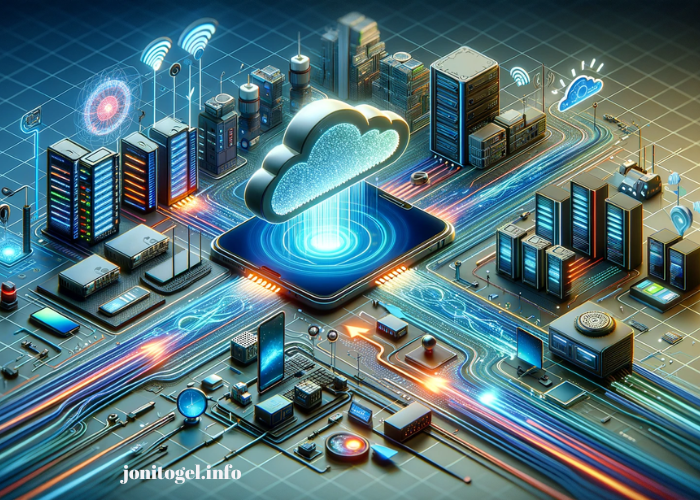In today’s rapidly evolving technological landscape, the need for real-time data processing has become more critical than ever. As the world becomes increasingly interconnected through the Internet of Things (IoT), artificial intelligence (AI), and other advanced technologies, the volume of data generated is growing exponentially. Traditional cloud computing models, while powerful, are often inadequate for handling the demands of real-time data processing due to latency issues, bandwidth limitations, and security concerns. This is where edge computing comes into play, offering a paradigm shift that brings computation and data storage closer to the data source. By reducing the distance that data must travel, edge computing enhances real-time data processing, providing faster, more reliable, and secure solutions for a wide range of applications.
Understanding Edge Computing
Edge computing refers to the practice of processing data closer to where it is generated, rather than relying on a centralized data center or cloud. This approach contrasts with traditional cloud computing, where data is sent to remote servers for processing and storage. In an edge computing architecture, data processing occurs at or near the “edge” of the network, meaning it is processed locally on devices like sensors, gateways, or local servers, rather than being transmitted to a distant cloud-based data center.
The concept of edge computing is not entirely new; it has its roots in content delivery networks (CDNs) and distributed computing models. However, the rise of IoT devices and the growing demand for real-time data processing have significantly accelerated its adoption. Edge computing is particularly valuable in scenarios where low latency, high bandwidth, and security are paramount, such as in autonomous vehicles, smart cities, industrial automation, and healthcare.
The Need for Real-Time Data Processing
Real-time data processing is the ability to analyze and act on data as it is generated, with minimal delay. This capability is crucial in a wide range of applications, from financial trading to emergency response systems, where milliseconds can make the difference between success and failure. However, achieving real-time data processing is challenging, especially when relying on traditional cloud computing models.
One of the primary challenges of cloud-based processing is latency—the delay between data generation and its processing. When data is sent to a centralized cloud server, it must travel over the internet, which can introduce significant delays, particularly in geographically dispersed networks. This latency can be problematic in time-sensitive applications, such as autonomous driving, where even a few milliseconds of delay can be critical.
Moreover, cloud computing relies on large-scale data centers, which can create bottlenecks due to bandwidth limitations. As the number of connected devices continues to grow, the sheer volume of data being transmitted to the cloud can overwhelm networks, leading to slower processing times and reduced efficiency.
Finally, security is a significant concern in cloud computing. Transmitting sensitive data over long distances increases the risk of interception and cyberattacks. While encryption and other security measures can mitigate these risks, they can also introduce additional latency, further complicating the goal of real-time data processing.
How Edge Computing Enhances Real-Time Data Processing
Edge computing addresses the challenges of real-time data processing by decentralizing computation and bringing it closer to the data source. This approach offers several key benefits that enhance the ability to process data in real-time.
Reduced Latency
One of the most significant advantages of edge computing is its ability to reduce latency. By processing data locally, edge computing eliminates the need to transmit data to a distant cloud server, thereby minimizing the delay between data generation and processing. This reduction in latency is particularly important in applications where real-time decision-making is critical, such as in autonomous vehicles, industrial automation, and augmented reality.
For example, in autonomous vehicles, sensors generate vast amounts of data that must be processed instantly to make split-second decisions. With edge computing, data from these sensors can be processed locally within the vehicle, enabling faster response times and enhancing safety.
Improved Bandwidth Efficiency
Edge computing also helps optimize bandwidth usage by reducing the amount of data that needs to be transmitted to the cloud. In many cases, only the most relevant or summarized data is sent to the cloud for further analysis or long-term storage, while the bulk of the processing is handled locally. This approach not only reduces the strain on network resources but also ensures that critical data can be processed more quickly.
For instance, in a smart city environment, sensors and cameras placed throughout the city generate massive amounts of data. Instead of sending all this data to a central cloud server, edge computing allows for local processing of the data, with only the most essential information being transmitted to the cloud. This reduces bandwidth usage and ensures that the city’s systems can respond to events in real-time.
Enhanced Security and Privacy
Security is another area where edge offers significant advantages. By keeping data closer to its source, edge reduces the risk of data breaches during transmission. Additionally, because data is processed locally, sensitive information can be anonymized or filtered before being sent to the cloud, further enhancing privacy.
In healthcare, for example, edge can be used to process patient data locally within a hospital or clinic, reducing the risk of sensitive information being intercepted during transmission. This localized processing also ensures that patient data is available for immediate analysis and decision-making, which is critical in emergency situations.
Scalability and Flexibility
Edge computing provides greater scalability and flexibility compared to traditional cloud computing models. By distributing processing across multiple edge devices, organizations can scale their operations more efficiently without overloading centralized cloud resources. This decentralized approach also allows for greater flexibility in deploying and managing applications, as processing can be tailored to specific local requirements.
In industrial settings, for example, edge computing can be used to monitor and control machinery in real-time, with each piece of equipment processing data locally. This decentralized approach enables more efficient operations, as each machine can be optimized individually, rather than relying on a central system to manage the entire production line.
The Future of Edge Computing
As technology continues to advance, the role of edge computing in enhancing real-time data processing will only grow. The proliferation of IoT devices, the increasing adoption of AI and machine learning, and the demand for faster, more secure data processing are all driving the need for edge computing solutions.
One area where edge computing is likely to see significant growth is in the deployment of 5G networks. With its promise of ultra-low latency and high-speed connectivity, 5G will enable even more advanced edge computing applications, from real-time video analytics to remote surgery. The combination of 5G and edge computing will create new opportunities for industries ranging from healthcare to manufacturing, enabling faster, more efficient, and more secure operations.
Moreover, as AI and machine learning algorithms become more sophisticated, the need for edge computing will become even more pronounced. By processing data at the edge, organizations can deploy AI models in real-time, enabling faster decision-making and more responsive systems. This capability will be particularly valuable in applications such as predictive maintenance, where real-time data analysis can help prevent equipment failures before they occur.
Conclusion
Edge computing represents a significant shift in the way data is processed, offering a powerful solution for enhancing real-time data processing. By reducing latency, improving bandwidth efficiency, enhancing security, and providing greater scalability, edge computing enables organizations to process data faster, more reliably, and with greater flexibility. As the world becomes increasingly connected and the demand for real-time data processing continues to grow, edge computing will play a crucial role in shaping the future of technology, driving innovation across industries and transforming the way we live and work.






